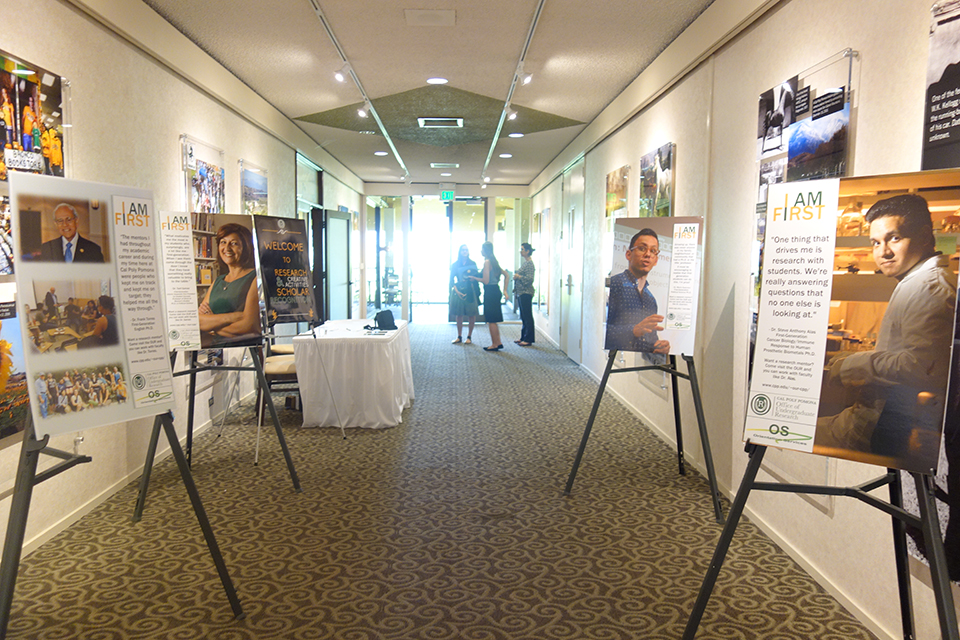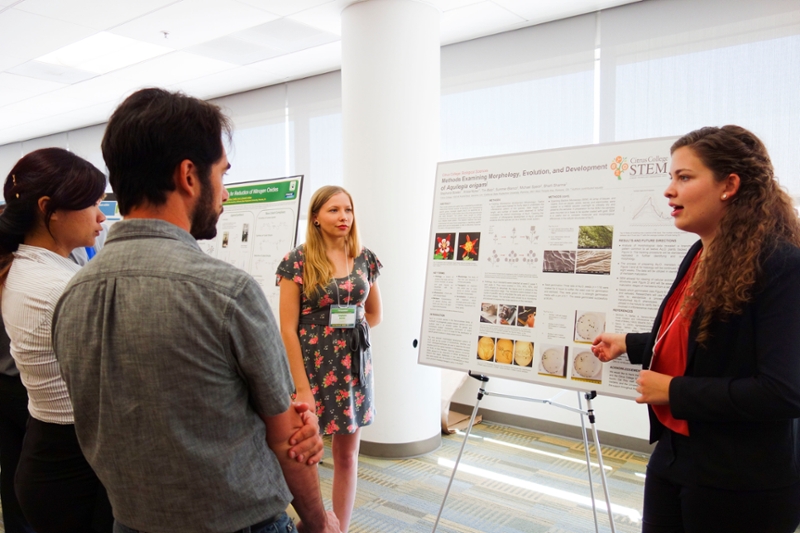Presenting Research Guidelines
Presenting Your Research
Presenting your research is a key component of conducting research. Some students conduct research to gather a more in-depth look into their field. Others are looking to build their research skills and portfolio. Whatever your reason may be for presenting, the task can seem a little intimidating at first. One way to combat this presentation anxiety is with careful preparation and understanding what is expected from your presentation. Knowing the guidelines for each type of presentation is the first step to making your presentation a hit with the crowd!
General Guidelines
1. Be organized!
Know the clear and unifying point of your research, and be able to communicate it to an audience.
2. Use the format of your academic discipline
Most research in the sciences and some social sciences is organized in the following components (or versions of them):
- Abstract
- Introduction
- Methods
- Results
- Discussion
- Conclusion
- References
- Acknowledgements
In other disciplines, these components may be less formal, but all research should have an introduction, address a question or problem, and discuss or analyze the results of its inquiry. Consult with your faculty mentor concerning the proper form for your presentation. The Purdue Online Writing Lab has a lot of resources online for student researchers including style guides. Student can also search past Student RSCA Conference abstracts through the Bronco Scholar University Online Repository website.
3. Make your research as accessible as possible to a broad academic audience, without sacrificing its disciplinary rigor.
4. Anticipate possible questions
Take notes on questions (and the names and addresses of the contacts you’ll make while discussing your work).
5. Rehearse your presentation in advance.
6. Credit all sources; be truthful; respect your audience
Oral & Performance Presentation Guidelines
- Rehearse your presentation in advance with friends or family. Make sure that it is no more than ten-minutes long. Ask your audience what they have learned to see if you're getting your point across.
- Establish early a clear and unifying point and repeat at least three times during your presentation.
- Clearly explain the applicability of your research to your discipline and/or the real world.
- Face your audience; speak slowly and clearly and project your voice to the back of the room. Whether you are working from notes (or slides) or reading from a text, make eye contact with your audience as frequently as you can.
- If you're speaking from notes, number them so that you won't lose your place, and remember the general outline of the points that you want to make and the order in which you'll make them. If you're reading, read slowly enough to understand what you're reading (at a rate of about two minutes per double-spaced page).
- If you are using visual aids, prepare them well in advance and make sure they are clear.
- Keep words to a minimum on visual aids; make sure they are readable from the back of the room. Words should be large enough to read from several feet away, but don’t use all caps. Avoid using light colors for words such as yellow or orange. The size of the typeface should be at least 14 point .
- Number your visual aids so you always know the order in case they get dropped or misplaced.
- Watch your audience response; if they seem lost, slow down.
- Bring a pen and pad of paper for notes and to record names and addresses of contacts.
Cal Poly Pomona will provide computers, projectors, and screens for students making oral presentations with visual aids. (PowerPoint is the only supported presentation software, it is the students’ responsibility to make sure the format, version, and presentation software works on the provided computers.) All computers are PCs. Participants should not bring their own computers.
- Students should bring presentations in a PC-compatible format on a USB memory drive.
- Presentations prepared on a Mac must be rehearsed at least once in advance on a PC to ensure compatibility.
- All presenters must indicate clearly the equipment they will need when abstracts are initially submitted.
- Presenters with questions about computer support should contact the conference organizers in advance at our-cpp@cpp.edu.
- A faculty moderator will chair your panel. He or she will introduce you and other presenters to the audience, describe the session's topic, keep time, and facilitate a brief discussion following each presentation. It is essential that panels keep on schedule; moderators will stop presenters if they appear likely to run over their allotted time.
- Arrive a minimum of 15 minutes before the beginning of your session in order to upload your presentation to the computer. Stay for the duration, sitting at the front of the room. Do not arrive late or leave following your presentation; this is discourteous to other presenters.
- Check all support materials in advance (PowerPoint presentations, handouts, transparencies, etc.) to avoid unnecessary delays in starting your presentation.
- Have a backup plan in the event of equipment failure (for instance, we recommend that you bring transparencies or handouts to guard against computer malfunctions if you're using PowerPoint).
- Listen to other panelists’ presentations and participate in discussions that follow.
The criteria below are used at the CSU Systemwide Student Research Competition that occurs after the annual conference in March. Ten student projects are selected from the campus conference to represent Cal Poly Pomona at the CSU Systemwide Student Research Competition that occurs later in the spring term (April/May each year). Each oral presentation will be judged on the following:
- Clarity of purpose
- Appropriateness of methodology
- Interpretation of results
- Value of the research or creative activity
- Ability of the presenter to articulate the research or creative activity
- Organization of the material presented
- Presenter's ability to handle questions from the panel and general audience
Poster & Creative Works Presentation Guidelines
Poster presentations should be no larger than 4'(width) x 3'(height) Landscape. When you apply to present, the conference will provide specific guidelines on whether your poster will be pinned to bulletin board or mounted on a hard backing that will be displayed on an individual easel. Follow the instructions provided by the specific conference. Also please note: NO TAPE, VELCRO, GLUESTICKS, or other permanent fasteners should be visible. If you require a special set-up for your presentation such as a table to display a prototype or design project, please notify the conference so that they can accommodate your request.
Space on a poster is limited, so pick wisely what to present. Your display should be self-explanatory and have a logical flow—others should be able to follow the order even if you are not present. Start with a rough draft of your design on paper, using graph paper or post-it notes to simulate sections.
Place your title at the top of the poster and make sure that the text is large (usually at least 2 inches in height) and clear. Include your name and major, and the name of your faculty mentor and his/her department name, the name of your school and the names of other co-authors. Incorporate appropriate graphics in your poster. Label or describe any charts, tables, figures, graphs, or photos that you use. Make sure all edges line up evenly. Edit, review, and spell check all the elements of your poster display. Be sure to firmly attach all materials to your poster board (spray adhesive, found in art supply stores, works best).
Depending on the conference, there may be an option to participate in a judged poster session. Below are some common criteria for judged poster sessions:
- Abstract and statement of problem
- Appropriateness of methodology
- Interpretation of results
- Future research and references
- Overall poster presentation (Organization and use of visual aids)
- Presenter's ability to handle questions from the judge panel
- Don't use more than two fonts. Instead use bold, italic and font size to set type differently. Times New Roman, Arial, and Garamond are suggested typefaces.
- Titles should be at least 2 inches high.
- The body type for the main sections should be at least 18 point if possible.
- Words should be large enough to read from several feet away, but don’t use all caps.
- Stick to a color scheme (try a couple that complement or contrast with each other such as black or navy on white). Try mounting text and figures on colored paper, or using some colored font.
- Be consistent with your white space between sections of text, figures and headings; white space should be ample so the poster doesn't’t look crammed.


